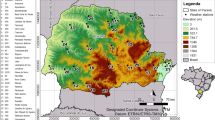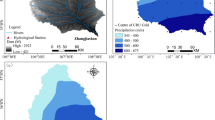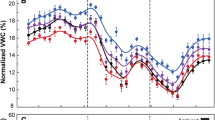Abstract
The effects of increasing CO2 concentrations on plant and carbon cycle have been extensively investigated; however, the effects of changes in plants on the hydrological cycle are still not fully understood. Increases in CO2 modify the stomatal conductance and water use of plants, which may have a considerable effect on the hydrological cycle. Using the carbon–climate feedback experiments from CMIP5, we estimated the responses of plants and hydrological cycle to rising CO2 concentrations to double of pre-industrial levels without climate change forcing. The mode results show that rising CO2 concentrations had a significant influence on the hydrological cycle by changing the evaporation and transpiration of plants and soils. The increases in the area covered by plant leaves result in the increases in vegetation evaporation. Besides, the physiological effects of stomatal closure were stronger than the opposite effects of changes in plant structure caused by the increases in LAI (leaf area index), which results in the decrease of transpiration. These two processes lead to overall decreases in evaporation, and then contribute to increases in soil moisture and total runoff. In the dry areas, the stronger increase in LAI caused the stronger increases in vegetation evaporation and then lead to the overall decreases in P − E (precipitation minus evaporation) and soil moisture. However, the soil moisture in sub-arid and wet areas would increase, and this may lead to the soil moisture deficit worse in the future in the dry areas. This study highlights the need to consider the different responses of plants and the hydrological cycle to rising CO2 in dry and wet areas in future water resources management, especially in water-limited areas.






Similar content being viewed by others
References
Allen, R. G., Pereira, L. S., Raes, D., & Smith, M. (1998). Crop evapotranspiration irrigation and drainage, 300(56), 300
Berg A, Findell K, Lintner B, Giannini A, Seneviratne SI, van den Hurk B et al (2016) Land–atmosphere feedbacks amplify aridity increase over land under global warming. Nat Clim Chang 6(9):869–874
Berg A, Sheffield J, Milly PCD (2017) Divergent surface and total soil moisture projections under global warming. Geophys Res Lett 44(1):236–244
Betts RA, Cox PM, Lee SE, Woodward FI (1997) Contrasting physiological and structural vegetation feedbacks in climate change simulations. Nature 387(6635):796–799
Betts RA, Boucher O, Collins M, Cox PM, Falloon PD, Gedney N et al (2007) Projected increase in continental runoff due to plant responses to increasing carbon dioxide. Nature 448(7157):1037–1041
Chen, M., Xie, P., Janowiak, J. E., & Arkin, P. A. (2002). Global land precipitation: A 50-yr monthly analysis based on gauge observations. Journal of Hydrometeorology, 3(3), 249–266
De Kauwe MG, Medlyn BE, Zaehle S, Walker AP, Dietze MC, Hickler T et al (2013) Forest water use and water use efficiency at elevated CO2: a model-data intercomparison at two contrasting temperate forest FACE sites. Glob Chang Biol 19(6):1759–1779
Donohue RJ, Roderick ML, McVicar TR, Farquhar GD (2013) Impact of CO2 fertilization on maximum foliage cover across the globe’s warm, arid environments. Geophys Res Lett 40(12):3031–3035
Feng S, Fu Q (2013) Expansion of global drylands under a warming climate. Atmos Chem Phys 13(19):10081–10094
Forkel M, Migliavacca M, Thonicke K, Reichstein M, Schaphoff S, Weber U, Carvalhais N (2015) Codominant water control on global interannual variability and trends in land surface phenology and greenness. Glob Chang Biol 21(9):3414–3435
Frank DC, Poulter B, Saurer M, Esper J, Huntingford C, Helle G, Treydte K, Zimmermann NE, Schleser GH, Ahlström A, Ciais P, Friedlingstein P, Levis S, Lomas M, Sitch S, Viovy N, Andreu-Hayles L, Bednarz Z, Berninger F, Boettger T, D‘Alessandro CM, Daux V, Filot M, Grabner M, Gutierrez E, Haupt M, Hilasvuori E, Jungner H, Kalela-Brundin M, Krapiec M, Leuenberger M, Loader NJ, Marah H, Masson-Delmotte V, Pazdur A, Pawelczyk S, Pierre M, Planells O, Pukiene R, Reynolds-Henne CE, Rinne KT, Saracino A, Sonninen E, Stievenard M, Switsur VR, Szczepanek M, Szychowska-Krapiec E, Todaro L, Waterhouse JS, Weigl M (2015) Water-use efficiency and transpiration across European forests during the Anthropocene. Nat Clim Chang 5(6):579–583
Gedney N, Cox PM, Betts RA, Boucher O, Huntingford C, Stott PA (2006) Detection of a direct carbon dioxide effect in continental river runoff records. Nature 439(7078):838
Huang M, Piao S, Sun Y, Ciais P, Cheng L, Mao J, Poulter B, Shi X, Zeng Z, Wang Y (2015) Change in terrestrial ecosystem water-use efficiency over the last three decades. Glob Chang Biol 21(6):2366–2378
Huang J, Yu H, Dai A, Wei Y, Kang L (2017) Drylands face potential threat under 2 °C global warming target. Nat Clim Chang 7(6):417–422
IPCC, 2013: Climate Change 2013: The Physical Science Basis. Contribution of Working Group I to the Fifth Assessment Report of the Intergovernmental Panel on Climate Change [Stocker, T.F., D. Qin, G.-K. Plattner, M. Tignor, S.K. Allen, J. Boschung, A. Nauels, Y. Xia, V. Bex and P.M. Midgley (eds.)]. Cambridge University Press, Cambridge, United Kingdom and New York, NY, USA, pp. 1535
Kolby Smith W, Reed SC, Cleveland CC, Ballantyne AP, Anderegg WRL, Wieder WR et al (2015) Large divergence of satellite and Earth system model estimates of global terrestrial CO2 fertilization. Nat Clim Chang 6(3):306–310
Mao J, Shi X, Thornton PE, Hoffman FM, Zhu Z, Myneni RB (2013) Global latitudinal-asymmetric vegetation growth trends and their driving mechanisms: 1982-2009. Remote Sens 5(3):1484–1497
Mao J, Fu W, Shi X, Ricciuto DM, Fisher JB, Dickinson RE et al (2015) Disentangling climatic and anthropogenic controls on global terrestrial evapotranspiration trends. Environ Res Lett 10(9):94008
Milly PCD, Dunne KA (2016) Potential evapotranspiration and continental drying. Nat Clim Chang 6(10):946–949
Novick KA, Ficklin DL, Stoy PC, Williams CA, Bohrer G, Oishi AC, Papuga SA, Blanken PD, Noormets A, Sulman BN, Scott RL, Wang L, Phillips RP (2016) The increasing importance of atmospheric demand for ecosystem water and carbon fluxes. Nat Clim Chang 6(11):1023–1027
Peng J, Dan L, Dong WJ (2014) Are there interactive effects of physiological and radiative forcing produced by increased CO2 concentration on changes of land hydrological cycle? Glob Planet Chang 112:64–78
Piao S, Friedlingstein P, Ciais P, de Noblet-Ducoudré N, Labat D, Zaehle S (2007) Changes in climate and land use have a larger direct impact than rising CO2 on global river runoff trends. Proc Natl Acad Sci U S A 104(39):15242–15247
Piao S, Yin G, Tan J, Cheng L, Huang M, Li Y, Liu R, Mao J, Myneni RB, Peng S, Poulter B, Shi X, Xiao Z, Zeng N, Zeng ZZ, Wang Y (2015) Detection and attribution of vegetation greening trend in China over the last 30 years. Glob Chang Biol 21(4):1601–1609
Poulter B, Frank D, Ciais P, Myneni RB, Andela N, Bi J et al (2014) Contribution of semi-arid ecosystems to interannual variability of the global carbon cycle. Nature 509(7502):600–603
Reich PB, Hobbie SE, Lee TD (2014) Plant growth enhancement by elevated CO2 eliminated by joint water and nitrogen limitation. Nat Geosci 7(12):920–924
Sellers PJ, Bounoua L, Collatz GJ, Randall DA, Dazlich DA, Los SO et al (1996) Comparison of radiative and physiological effects of doubled atmospheric CO_2 on climate. Science 271(5):1402–1406
Swann ALS, Hoffman FM, Koven CD, Randerson JT (2016) Plant responses to increasing CO 2 reduce estimates of climate impacts on arid severity. Proc Natl Acad Sci 113(36):10019–10024
Taylor KE, Stouffer RJ, Meehl GA (2012) An overview of CMIP5 and the experiment design. Bull Am Meteorol Soc 93(4):485–498
Trancoso R, Larsen JR, McVicar TR, Phinn SR, McAlpine CA (2017) CO2-vegetation feedbacks and other climate changes implicated in reducing base flow. Geophys Res Lett 44(5):2310–2318
Ukkola AM, Prentice IC, Keenan TF, van Dijk AIJM, Viney NR, Myneni RB, Bi J (2015) Reduced streamflow in water-stressed climates consistent with CO2 effects on vegetation. Nat Clim Chang 6(1):75–78
Ukkola AM, Keenan TF, Kelley DI, Prentice IC (2016) Vegetation plays an important role in mediating future water resources. Environ Res Lett 11(9):94022
UNEP (United Nations Environment Programme) World Atlas of Desertification 182(Edward Arnold, 1997)
University of East Anglia Climatic Research Unit, Harris, I.C, Jones, P.D. (2017): CRU TS4.00: climatic research unit (CRU) time-series (TS) version 4.00 of high resolution gridded data of month-by-month variation in climate (Jan. 1901-Dec. 2015). Centre for Environmental Data Analysis. https://doi.org/10.5285/58a8802721c94c66ae45c3baa4d814d0
Yang H, Piao S, Zeng Z, Ciais P, Yin Y, Friedlingstein P, Wang L (2015) Multicriteria evaluation of discharge simulation in dynamic global vegetation models. J Geophys Res Atmos 120:7488–7505
Yang Y, Guan H, Batelaan O, McVicar TR, Long D, Piao S, Simmons CT (2016a) Contrasting responses of water use efficiency to arid across global terrestrial ecosystems. Sci Rep 6(1):23284
Yang Y, Donohue RJ, McVicar TR, Roderick ML, Beck HE (2016b) Long-term CO2 fertilization increases vegetation productivity and has little effect on hydrological partitioning in tropical rainforests. J Geophys Res Biogeosci 121:2125–2140
Zhu Z, Piao S, Myneni RB, Huang M, Zeng Z, Canadell JG, Zeng N (2016) Greening of the earth and its drivers. Nat Clim Chang 6(8):791–795
Funding
This study was funded by the National Key Research and Development Program of China Grant (2016YFA0602703), the Key Program of the National Natural Science Foundation of China (Grant No. 41330527), the National Natural Science Foundation of China (41605036), the National-Level Major Cultivation Project of Guangdong Province (2014GKXM058), and the China Postdoctoral Fund (No.2016M591108).
Author information
Authors and Affiliations
Corresponding author
Electronic supplementary material
ESM 1
(DOCX 397 kb)
Rights and permissions
About this article
Cite this article
Hong, T., Dong, W., Ji, D. et al. The response of vegetation to rising CO2 concentrations plays an important role in future changes in the hydrological cycle. Theor Appl Climatol 136, 135–144 (2019). https://doi.org/10.1007/s00704-018-2476-7
Received:
Accepted:
Published:
Issue Date:
DOI: https://doi.org/10.1007/s00704-018-2476-7




